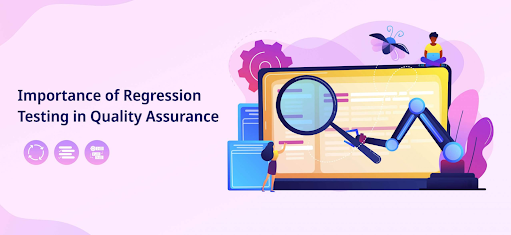Introduction:
The world is constantly evolving, and so must the software we rely on. In software development, even a single line of code in developing software can significantly affect its other features. In such cases, software development companies need to revisit these features to ensure they still function correctly after introducing new changes. This is where following regression testing best practices becomes essential. It acts as a safety check, making sure that the software stays reliable and works properly even after new changes and updates are made. In this article, we are going to uncover “What is regression testing?” in the software world. Here, we prepare a detailed guide to help you understand how to get started and the best tools for regression testing.
What is Regression Testing?

In our regression testing guide, the first thing to be discussed is regression testing itself. Regression testing is a vital aspect of software testing. It involves assessing previously released software to ensure that no existing functionality has been disrupted by recent changes or modifications. This process helps maintain the overall stability and functionality of the software’s current features by verifying that they continue to work as intended. Good regression testing strategies use both manual and automated tests to thoroughly check software changes.
Why Regression Testing Is Important

Regression testing is the process of testing all aspects of changes made in the application and as a result following regression testing best practices is very essential. Following are some points in our regression testing guide that can help you better understand the importance of it:
Maintains Stability
Regression testing assists in averting the introduction of brand-new issues in the system, as this maintains the stability of the software; once a bug has been found, issues are prevented from getting worse. This is a very important benefit of the regression testing process.
Ensures Quality
They make it possible to check whether the new updates have compromised the existing functionality of the software thus ensuring that it continues to meet the expectations of the users after changes have been made. This is another benefit that you can get with the help of a regression testing framework.
Saves Time and Costs
With proper implementation of regression testing frameworks, problems can be detected as early as possible. This can lead to larger cost savings concerning fixing such problems in the development phase where they could be very numerous and time-consuming.
Improves User Experience
Testing the interactivity of all developed features with the help of regression testing software after some updates will give the users more confidence in the usage of applications. This is a prime benefit that one can get from regression testing software.
Supports Continuous Integration
When CI is being applied, automated regression testing is vital, particularly in the organization’s working environment. This means that it is possible to create the application and set it live simultaneously and yet offer the assurance that the thing users are employing is not going to fail them. So whenever automated regression testing is applied, continuous integration can be ensured.
Facilitates Compliance
The next benefit that you can get by applying regression testing techniques is compliance. In industries that function in highly regulated settings, regression testing assists in ensuring that software does not veer from legal compliance as it changes.
How To Get Started With Regression Testing?
For a comprehensive regression testing tutorial, explore step-by-step guides that cover the essentials of setting up, executing, and analyzing regression tests and regression testing techniques. When it comes to regression testing, focusing on critical capabilities is key. following these essential steps ensures a comprehensive regression testing process.
1. Identify Source Code Changes
The first step in building robust regression testing strategies is to identify where the latest code changes have occurred and assess their impact. Code reviews are crucial for pinpointing the components or modules that were modified and understanding how these changes affect existing features. Tools like Git, a version control system, are often used to compare differences between the old and new code in reliable regression testing methods.
2. Prioritize Impacted Areas and Test Cases
Once the changes are identified, QA teams prioritize which areas and test cases need extensive testing. Changes impacting core features or significantly altering the application’s functionality should always be the top priority.
Prioritization becomes even more critical as the codebase grows in robust regression testing methods. The time required to complete all tests can stretch across months or an entire development sprint. Due to its repetitive nature, regression testing is often automated, with many teams standardizing the process using various automation tools.
3. Define Entry and Exit Criteria
With priorities set, the team selects the tests to be executed. Typically, testing teams have a range of test suites ready but only execute the relevant ones for each regression testing session. At this stage, a step-by-step plan is formulated, and the appropriate testing system is prepared. It’s also important to discard obsolete test cases or suites for better test management in the future.
4. Categorize Regression Test Cases
For the regression testing tutorial, the next, the plan is refined by categorizing test cases according to various factors:
Manual vs. Automated Tests: Manual testing is ideal for ad-hoc or non-repetitive scenarios that require human evaluation. Automated testing should handle repetitive test cases.
Critical vs. Non-Critical Features: Assign importance levels (high, medium, low) to test cases based on urgency and significance.
Testing Types: Classify tests by type (e.g., functional, non-functional) to manage them more effectively. Many teams now use centralized testing systems to handle multiple test types without constantly switching platforms.
5. Prepare the Test Environment
A stable and ready-to-use test environment is essential for frequent regression testing. As new code is continuously developed, the environment must remain consistent to avoid disrupting the testing schedule. Poor setup can lead to failed tests, missed defects, and false positives/negatives.
Cloud Environments vs. Physical Devices: Setting up physical devices requires collaboration across teams and can introduce operational inefficiencies. Cloud testing environments offer scalability and are particularly beneficial for applications with dynamic loads. However, physical devices are still necessary for specific applications, like games, requiring customization in components like graphics cards or processors.
6. Schedule and Execute Tests
With all test cases prepared, teams can schedule them for execution based on the test plan. Some test cases can be set to run periodically throughout the development cycle. Time-based execution allows for greater quality control as the application evolves.
7. Measure Regression Testing Success
Finally, analytics play a crucial role in evaluating the success of regression testing. Test reports provide insights into testing efficiency and help QA managers make data-driven decisions. These reports can also highlight weak points in the application, allowing for timely adjustments by the development team.
Regression Testing Tools
Several methods can be used in regression testing as follows: Here’s a look at some of the most popular options:
Selenium:
Selenium is the most popular and well-known open-source automation tool that is compatible with Java, Python, C#, and many more. Perfect for web apps, and also enables automation of browsers; good for regression testing.
JUnit:
Primarily developed for Java applications, JUnit is one type of unit testing framework capable of regression testing. It permits you to create and perform scripts for writing repeatable tests and you can use it with other tools such as Maven or Gradle.
TestNG:
Developed based on JUnit, an advanced framework is TestNG, which is more suitable to be used in the level of high testing. Some extra things that it has been that we can associate tests with parallels and configuration, as well as manage particular test cases more efficiently.
QTP/UFT:
Quick Test Professional is a commercial tool, now called Unified Functional Testing or UFT, developed by Micro Focus. Regression testing is an especially beneficial solution for applications that are developed using various technologies.
Apache JMeter:
While best suited for performance testing JMeter can easily be used for regression testing, especially in APIs and other such services. Meter supports various protocols, including HTTP, HTTPS, SOAP, REST, FTP, and JDBC. This makes it a versatile tool for regression testing across different types of services and APIs.
Cucumber:
Cucumber is very good for BDD, and what people like about it is that you can use it when you want to run a regression test with the participation of regular analysts. It permits writing test cases in a format that is easily understandable to even a layman.
Katalon Studio:
Katalon Studio as a test automation solution is designed to test web, API, mobile, and desktop applications. Due to its high usability and functional capabilities, it is recommended for regression testing irrespective of the work platform.
Conclusion:
Thus, regression testing is a critical concept in the software development life cycle. Even though new changes take time to develop, they can maintain the quality and stability of the implemented software applications by reducing the harm that new changes may cause to other functions. They opt to focus on “what is regression testing?”, determining major test cases, automation of tests, and the use of appropriate tools in the regression testing to ensure that good software is developed. Leveraging the right regression testing tools, such as Selenium, JUnit, or JMeter, can further streamline your testing efforts, making regression testing not just a safety net but a vital component of your continuous integration and development processes.






